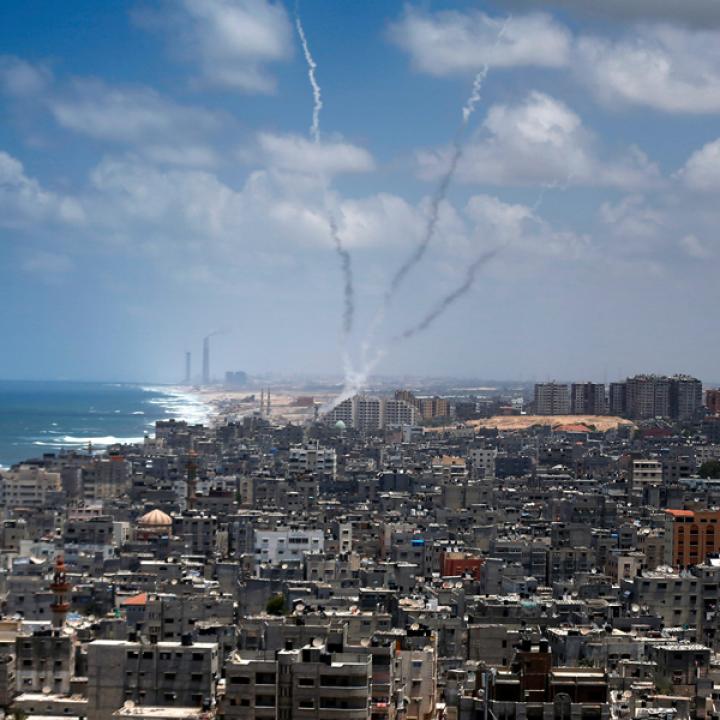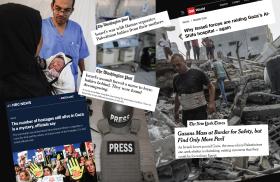
- Policy Analysis
- Fikra Forum
Remembering Gaza Disengagement 13 Years Later: Personal Reflections on a Missed Opportunity

Introduction
It is sometimes hard to imagine in 2018 that a different vision existed for Gaza than the one that currently exists in the news, and that Gazans live daily. Yet, I was a member of a hopeful group of technocrats who developed a clear roadmap for Gaza after Israel unilateral disengagement in 2005, and then watched as that plan collapsed. The lessons from that period on why this more optimistic vision for Gaza failed are a necessary portion of the broader conversation on the Israeli-Palestinian conflict, and are an important antidote to a narrative that presents the rise of Hamas and the ensuing violence as inevitable. Yet it is vital for international and regional actors alike to reflect on what has not worked in regards to technical aid to Gaza as the international community continues to struggle to find a solution to a worsening crisis.
The Day Israel Left Gaza
In the early morning hours of September 12, 2005, I was among the first people to enter the evacuated Jewish settlement of Netzarim, located to the south of Gaza City, as the last Israeli soldiers left the Strip. At sun rise, I was in Gush Katif, the largest Israeli settlement block stretching along Gaza’s beautiful southern coast on the Mediterranean. From there, I continued to the Palestinian side of Rafah border crossing that was also evacuated along with the 13-km long Philadilphi Route at the Gaza-Egyptian border. I ended my day at the three evacuated small settlements of Dugit, Nisanit, and Elei Sinai located along the northern Gaza-Israeli fence and at Erez Industrial zone.
The scene I observed in the ex-settlements that day was one of utter anarchy and total chaos. Tens of thousands of people from Gaza’s eight refugee camps and the few small towns adjacent to the settlements spread out over the evacuated properties and took what they could from the buildings the Israeli settlers had left behind —from pipes and doors to concrete and other basic building materials. The Palestinian police that had been assigned to provide security was nowhere in sight. Only the green houses in the middle and southern settlements remained intact due to the presence of private security guards hired in advance for protection. By the end of the day, little was left except for rubble and debris.
Palestinian Preparations for the Day After
I travelled to these locations at such a relentless pace as one of approximately 40 Palestinian professionals assembled to prepare Gaza for the day after the disengagement. The team included top technical experts in agriculture, industry, trade, border crossings, water, electricity, sanitation, land zoning, housing, and telecommunications. We mostly hailed from Gaza, aided by a small number of legal, trade, and water experts from the Ramallah-based PLO’s Negotiations Support Unit.
Our team also worked in close coordination with the World Bank and the UNDP, as well as other international organizations operating in the Palestinian areas. Periodically, we held meetings with the Palestinian civil society, the private sector, and the political factions in both the Gaza Strip and the West Bank from whom we sought feedback on our work after we presented it to them. The donor community and the representatives of the diplomatic missions in the Palestinian Authority (PA) were also briefed on our technical plans. The overall impression we received in all of these meetings was positive and very encouraging.
On November 15, two months after Israel's unilateral withdrawal from Gaza, the United States brokered the Agreement on Movement and Access (AMA) between Israel and the PA. This agreement appeared to greatly enhance the prospects of successful implementation of our technical plans for post-disengagement Gaza. The AMA was designed to improve Gaza’s cross-border commercial transactions with Israel, allowing for a secure passage between Gaza and the West Bank. The AMA also dealt with agricultural exports from former Israeli settlements in Gaza, outlined the operational strategy of the EU-monitored Rafah border crossing, and contained articles about resuming the talks on constructing Gaza seaport and the re-building of Gaza airport, which was destroyed during the first months of the second intifada that erupted on September 28, 2000.
Dashed Hopes
Our technocratic hopes and aspirations for a new chapter in Gaza’s history were soon dashed. The challenges posed by the broader Israeli-Palestinian conflict and internal Palestinian politics proved more powerful than our technical plans for Gaza. This is not to say that we were necessarily naïve; we did not expect a smooth implementation of our plans, or of the AMA itself for that matter. Yet, not even in our worst nightmares could we have envisioned Gaza as it stands today: a place torn by more than a decade of bitter Palestinian political division, three destructive wars between Hamas and Israel, and by a suffocating blockade and near total isolation from the rest of the world. Indeed, 13 years after the disengagement, Gazans are struggling with high rates of unemployment, poverty, and food insecurity; with collapsed basic services and public infrastructure; with a crippled private sector; and with a widespread state of utter despair that engulf Gaza’s two million inhabitants.
Israel, Hamas, and the Realities of Disengagement
A confluence of factors led to this unfortunate outcome. Chief among them is the way in which Israel and Hamas perceived and presented the disengagement plan and its implementation.
On the Israeli side, although the plan to evacuate Gaza – which took all by surprise when first announced in December 2003 by former Prime Minister Ariel Sharon – was largely motivated by Israel’s own strategic interest, the Israeli departure from Gaza was all but inevitable; a point often neglected in writings about the Gaza disengagement. Unlike the occupation of the West Bank, the prospect of a long-term Israeli occupation of Gaza had never existed or made strategical sense. Neither the geography nor the demography of the place would have allowed for a prolonged Israeli presence in the midst of a young and burgeoning Palestinian population squeezed into a small territory. Gaza, after all, is a narrow strip of land considered to be one of the most densely populated regions on earth: at the time of the disengagement, its population stood at 1.3 million, with an annual growth rate of 3.5 percent. In light of these circumstances, the Israeli disengagement was, in fact, predictable on a strategic level. It was only a matter of time.
In contrast, Hamas presented the disengagement as a victory that proved the effectiveness of its armed resistance in the fight to “liberate” Gaza. The fact that the process had not yet ended mattered little to Hamas (after the disengagement, Israel continued to retain exclusive control over Gaza’s air space and territorial waters, the Palestinian population registry, electromagnetic space, and the movement of goods and people to and from Gaza in any location other than the Rafah border crossing with Egypt).
In the rush to capitalize on its self-proclaimed achievement of Intisar al moqawama (the victory of the armed resistance), Hamas competed against the secular Fatah party in the Palestinian legislative elections of January 2006, which – against predictions – it ultimately won.
And so, as the last Israeli soldier left Gaza in the early morning hours of September 12, 2005, Gaza was in effect sealed and delivered to Hamas. The delivery was made official following Hamas’s electoral victory in early 2006, and was finalized in mid-June 2007 with the organization’s violent takeover of the entire Gaza Strip. As the dramatic years that followed had shown, it was all downhill from there for Gaza.
Missed Opportunity?
As both Israel and Hamas were framing the disengagement in a manner that served their own political interests, it was difficult for international actors to make the disengagement work and deliver tangible economic benefits to Gaza. And there were several attempts on that front.
In December 2004, the World Bank led the way by drafting a set of technical papers containing suggestions on how to modernize Gaza border crossings with Israel, establish industrial parks and export zones, and make the Palestinian economy competitive. On April 14, 2005, the former head of the World Bank, James Wolfensohn was appointed as the Middle East Quartet Special Envoy for Gaza Disengagement. Two months later, the G-8 summit held in Gleneagles, Scotland, pledged financial support of up to $3 billion per year over a three year period to help Mr. Wolfensohn carry out his assignment. Other private sector initiatives to help Gaza included investment in former Israeli settlements’ green houses in southern Gaza, and in the Erez industrial estate located in the northern tip of the Gaza Strip.
Today, these international efforts – all part of the disengagement early history –seem a distant memory, lost in the destruction that wrecked Gaza in recent past. Had the full implementation of such initiatives been allowed, they could have offered Gaza a good shot at a different future. That, however, did not happen. With both Israel and Hamas having conflicting narratives about disengagement, failure was all but certain. Furthermore, the international efforts were purely of a technical nature, and, as such, were inherently ill-suited for dealing with challenges that were deeply rooted in a highly intricate conflict setting. And it did not take long for these international efforts to reach a dead-end when, in January 2006, they were stalled by the startling rise of Hamas to power, and later came to a complete halt with Hamas armed takeover of Gaza in mid 2007.
Lessons Learned
The disengagement plan has failed to alter Gaza’s prolonged misfortune. One can list many reasons for this outcome. But one lesson is clear: technical solutions to Gaza’s complex problems, absent supportive political and security setting, are not likely to work. This much we already know. Yet, this lesson and its policy implications, doesn’t seem to be well understood today. For instance, despite the increasingly growing realization that deterioration in Gaza’s living conditions is fast approaching and may have even already passed a breaking point, the proposed solutions to the crisis, whether from the Israeli military establishment or from the current US administration, are all in the form of a “list of mega projects” to save Gaza’s collapsing economy. Vital as such undertaking may be for addressing Gaza’s mounting socioeconomic difficulties and the chronic shortages in its basic public services, these projects, based on the experience of post-disengagement Gaza, can only be fully implemented if and only if Gaza’s political and security situation is stabilized first. This condition brings the Gaza question back to its wider context where it belongs, and where much work still needs to be done on that front by all concerned parties, including the Palestinians themselves.


